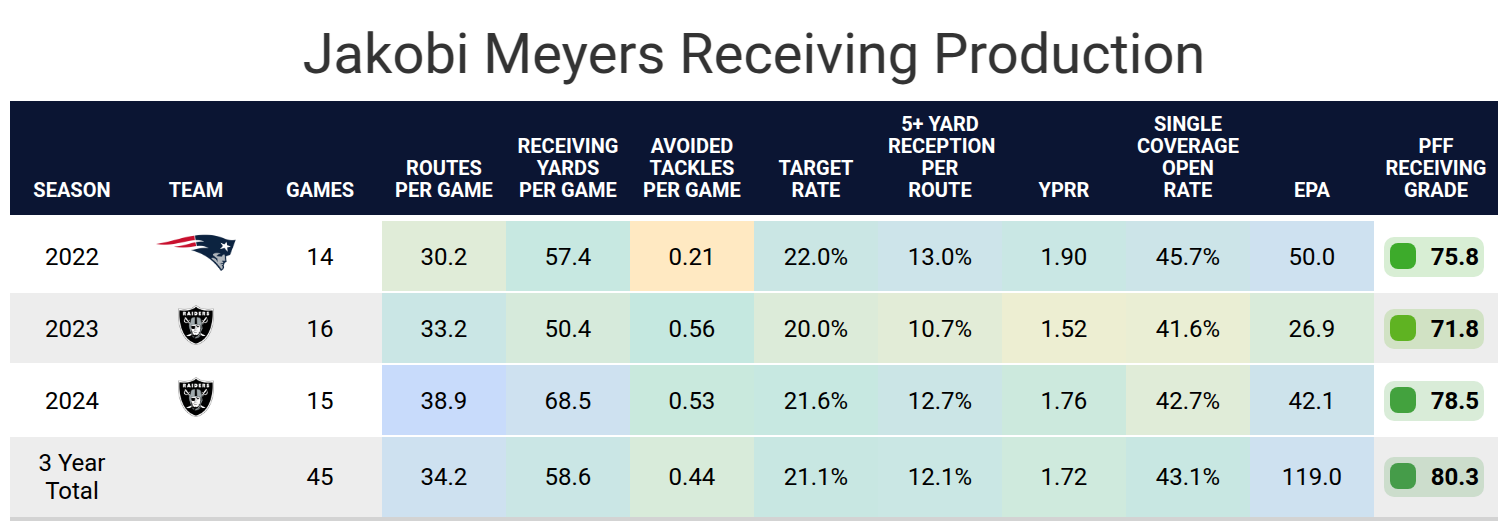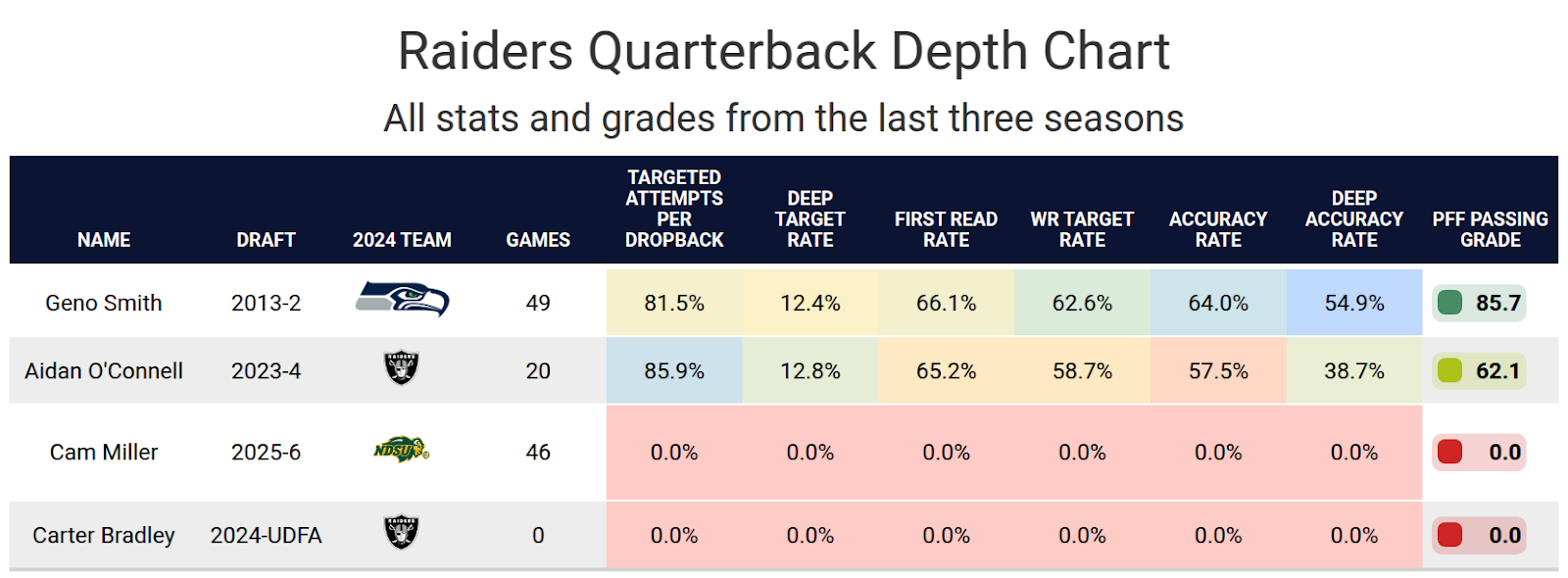- Jakobi Meyers gets a new quarterback: The Las Vegas Raiders added Geno Smith, giving Meyers a much-needed upgrade at the position, which should help his touchdown total.
- The Raiders add more competition: Las Vegas also added Ashton Jeanty at running back and three wide receivers in the draft, which could mean fewer passes for Meyers.
- Subscribe to PFF+: Get access to player grades, PFF Premium Stats, fantasy football rankings, all of the PFF fantasy draft research tools and more!
Estimated Reading Time: 5 minutes

PFF’s Fantasy Football Player Profile series delivers the most in-depth fantasy football analysis available for the 2025 season.
Using PFF’s exclusive data, we evaluate player performance, competition for touches and how teammates and coaching staffs
Last updated: 7:15 a.m. Wednesday, May 28
Player performance
Meyers was an undrafted rookie for the New England Patriots in 2019. He was able to emerge as part of a heavy rotation, with Julian Edelman as the clear lead wide receiver, but Phillip Dorsett, Mohamed Sanu, Josh Gordon and N’Keal Harry all rotating with Meyers. Edelman was injured after six games of the 2020 season, which ended up being the last six games of his career. Meyers took over as the primary slot receiver, becoming a weekly starter. He led the wide receiver room in snaps, routes, targets, receptions and yards over the rest of the season.
Meyers remained the top receiver for the Patriots in 2021 and 2022, but he was rarely a target in the red zone and was rotated out more than most top wide receivers. He only recorded three 100-yard games over his four years with the Patriots. He finished as WR40 and WR30 in points per game over the two seasons. He signed with the Las Vegas Raiders in free agency, reuniting him with Josh McDaniels. The Raiders also added Davante Adams, which turned Meyers from the top wide receiver to the second option. Most of Meyers' stats decreased with the move, but the Raiders rotated him out less often than the Patriots, and he became more of a red zone target. These two positives outweighed the negatives, leading to the 24th-most fantasy points per game.
In 2024, Adams only lasted three games with the Raiders before he was injured and then traded. The Raiders' depth at wide receiver was thin, so he played at least 90% of Las Vegas' offensive snaps in two-thirds of his games. He caught a minimum of two catches for 25 yards each game and doubled his number of career 100-yard games from three to six. The high target rate and yards per game should have led to a big increase in his fantasy value, but instead, he was only WR23 in fantasy points per game. The reason for the slight increase was a drop in touchdowns. While he was targeted 10 times in the end zone, only three of those passes were catchable, and one was called back due to a penalty. This led his touchdown total to be cut in half.


Projected role
Meyers' primary competition for targets is tight end Brock Bowers, but a team can generally have two receivers co-exist for fantasy purposes, which was true with the Raiders last season. The Raiders spent a lot of their draft capital on new offensive talent. Their first round pick was spent on running back Ashton Jeanty, while their second, fourth and sixth round picks were all on wide receivers. Jack Bech is all but guaranteed to be on the field in most three-wide receiver sets, and there is also a chance Dont’e Thornton Jr. could also surpass Tre Tucker in the depth chart. Meyers has generally played a little better out wide compared to in the slot, and Bech has the versatility to play both outside and inside. Bech may be able to help Meyers' fantasy value more than he hurts it.
The primary concern is with Jeanty. The Raiders had the lowest team run grade last season, and now they could have one of the highest. This is very likely to allow the Raiders to run the ball more often, leading to Meyers running fewer routes. His 38.9 routes per game last season ranked fourth-most among wide receivers, and that is very likely to decrease thanks to Jeanty.


Impact of teammates
Meyers will be playing with a new head coach in Pete Carroll and a new offensive coordinator in Chip Kelly, whose had success with wide receivers of all shapes and sizes, so the offense shouldn’t have much of a problem getting Meyers involved. There is also some concern that when a new regime brings in new players, those new players will become the bigger priority while the older players will become less of a priority.
The good news is that Meyers should be playing with the best quarterback of his NFL career. Tom Brady was the best quarterback he played with before this season, but that was his rookie season, where he didn’t play a lot, and Brady didn’t grade as well in his final season with the New England Patriots as he did the rest of his career. Smith graded better each of the last two seasons. Brady happens to still be a part of Meyers' career as the minority owner of the Raiders. Smith notably has a great deep target rate. Meyers typically sees deeper targets than the average slot receiver. It will be interesting to see how much Meyers gets utilized deep, but this could be further good news for Meyers.

Bottom line
Meyers has always been able to outperform his talent dude to a lack of competition for touches. The Raiders have largely reworked their offense, but Meyers still appears to be the top wide receiver on the depth chart. The changes create volatility in Meyers’ potential outcomes. He’s very unlikely to finish among the top-10 fantasy wide receivers, but he’s a solid bet to remain a fantasy starter.

Footnotes
- Statistics in tables and charts were chosen based on their ability to predict future fantasy performance on a per-game or per-opportunity basis or to describe the player relative to others at the same position.
- “Opportunities” are defined as passing dropbacks, rushing attempts and routes run as a receiver.
- Numbers are provided either by season or based on the past three years. For rookies, only college statistics are included. For non-rookies, only NFL statistics are considered, regardless of whether they played in college within the previous three years.
- As college competition is easier than NFL competition, most rookies are likely to see a decline from their historical numbers.
- Only FBS data is considered for college players and comparisons.
- Kneel-downs are removed from rushing data to provide cleaner quarterback rushing rate statistics.
- The table colors in this article range from blue (indicating good/high) to red (indicating bad/low).
- All percentiles and color codings compare the given player to others with a high sample of opportunities. Generally, the cutoff is one-third of the possible opportunities in the sample. If a player does not meet the threshold, they are still included in the comparison, though their results may appear better or worse than expected due to the smaller, less predictive sample size.
- Information on utilization classifications and their importance can be found here for running backs, wide receivers and tight ends.



 © 2025 PFF - all rights reserved.
© 2025 PFF - all rights reserved.